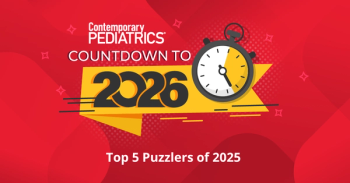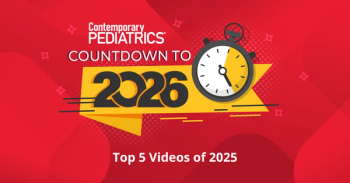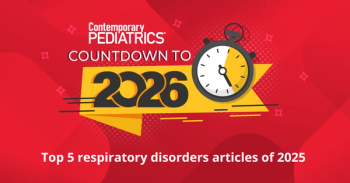
- September 2025
- Volume 41
- Issue 6
Psychosocial screening of adolescents: Using the HEADS FIRST Checklist, part 1
Discover effective strategies for conducting psychosocial screenings in adolescents using the HEADS FIRST Checklist to enhance health outcomes.
Obtaining a psychosocial history from adolescents can pose a challenge for even the most experienced clinicians. Yet this is arguably the most important part of the routine adolescent health care visit. For example, motor vehicle accidents, as well as homicides and suicides, each account for several thousand young adult deaths annually, with alcohol being a factor in many of these fatalities.1-3 In addition, nearly 2000 adolescents die every year from an unintentional opioid overdose, mostly attributable to the widespread availability of illicitly manufactured fentanyls.4 Sexually transmitted infections, pregnancy, eating disorders, and abuse/neglect are also associated with significant adverse sequelae in youth.5-8 Perhaps most striking is that the vast majority of these occurrences are preventable. Implementing a comprehensive, organized approach to understand a patient’s strengths and risks can be challenging in a busy practice. This article aims to illustrate how this can be accomplished using the HEADS FIRST Checklist (Figure) as a quick, concise, and easy-to-use screening tool for meeting the comprehensive health care needs of adolescents and young adults.
Several interview instruments exist to elicit a psychosocial history from adolescents.9-11 The HEADS FIRST Checklist is structured to offer pediatric practitioners a more streamlined, up-to-date approach to this important topic. It is especially notable that our checklist can be further differentiated from other methods by featuring specific questions about abuse, body image, and gender identity. For more than 30 years, the HEADS FIRST Checklist has been used as a clinical and undergraduate and graduate medical teaching tool at our institution to address sensitive topics that comprise the major causes of morbidity and mortality in adolescents and young adults. The checklist has been modified and updated numerous times since it was initially published in Pediatrics in Review in 1994.12 This method highlights the importance of getting into adolescents’ heads first, to connect with them meaningfully and genuinely, in an effort to reduce risk-taking behaviors. We also use the word “first” as part of the acronym to heighten awareness that the psychosocial history should be considered the most important component of the routine adolescent checkup and even more important than the physical examination itself.
It is preferable to identify teens at risk proactively rather than reactively. The annual health checkup provides an excellent opportunity to accomplish this goal. Although it is ideal to identify psychosocial issues early, issues in the HEADS FIRST categories may also present with medical symptoms at an acute or sick visit, including during a hospitalization. There is no substitute for a carefully performed psychosocial history, especially when underlying risk factors or behaviors may not be readily apparent or disclosed. This is particularly true when topics are seen as stigmatized, too personal, or taboo. Clinicians must initiate conversations addressing these sensitive topics, just as we ask about headaches, chest pain, rashes, etc. The psychosocial history is equally important for youth with disabilities or chronic medical conditions as they face similar challenges as their healthier peers. Furthermore, they must deal with the effects of their underlying disorder as an added stressor.
Basic clinical approach to the HEADS FIRST history
The HEADS FIRST topics are interrelated, and problems in one area may be closely linked to issues in other areas. Because of this, in practice, the topics on the checklist may flow conversationally; the checklist is not meant to be used strictly in order. The questions can be sequenced in accordance with the flow of the interview at the practitioner’s discretion. Topics that the examiner perceives to be especially sensitive for an individual patient can be reserved for later in the conversation as deemed appropriate. We proceed with clear, direct, focused trigger questions (Figure) and follow up with open-ended questions.
Though it has been shown that patients and their parents expect the topics listed in the HEADS FIRST Checklist to be discussed as part of routine adolescent health care,13 patients’ readiness to answer certain questions on the HEADS FIRST Checklist varies. Practitioners who care for adolescents are accustomed to adjusting the medical history to the developmental level of their patients and should tailor the timing of this interview to individual patient needs. The HEADS FIRST screening tool addresses deeply personal, complex, intertwined, and potentially anxiety-provoking or stigmatized topics. Fostering a mutually respectful, strengths-based conversation is the most important element of implementation. It must be stressed that trust and respect are not automatic and must be earned by both the clinician and the patient. In our office, starting at the 11- or 12-year visit, we meet with the patient and parents together to review the general medical history, discuss any concerns, and address privacy. In some cases, it may be pertinent to weave some of the HEADS FIRST topics into the history of the present illness while the parents are still in the room. We then excuse the parents (assuring them of private time with the clinician if desired) and meet with the patient alone in the exam room, unless the patient desires the presence of others.
The provision of confidential health care, whenever possible, is an essential component of adolescent medicine.14 Recommendations for optimizing confidentiality practices and protections for adolescents and young adults within the pediatric practice setting are outlined per American Academy of Pediatrics (AAP) guidelines.14 Practitioners must be aware of adolescent privacy laws in their state, as there is state-by-state variability in the legal rights for minors.15 If confidential care is not provided, adolescents may withhold information and not return for subsequent visits.16 Beyond legal rights and access to care, speaking with the adolescent alone supports their emerging autonomy and allows them to practice talking with their health care practitioner.
The physical examination is then performed in the presence of a chaperone, as indicated per AAP guidelines.17 In our practice, the HEADS FIRST questions are asked after the physical is completed. Obtaining the HEADS FIRST psychosocial screen in the exam room rather than externally (eg, online, at home, or in the patient waiting area) may help promote and preserve privacy. Confidentiality may be more difficult with previsit electronic questionnaires. Another challenge with written screens is that they cannot be adjusted to each patient’s educational and developmental level in real time.
When taking the HEADS FIRST history, it is suggested to begin with nonthreatening “buffer questions” on topics that are usually less sensitive and that teenagers enjoy talking about, such as their recreational habits and favorite activities. These questions focus the interview on the patient’s strengths and potential. A strengths-based approach, where adolescents are understood and appreciated as whole persons rather than a collection of risk behaviors, can mitigate shame and promote effective communication.
We have found it striking how most adolescents will answer most questions openly and honestly most of the time, even to a total stranger during the first visit. Even if they are unwilling or unable to disclose sensitive information at any one visit, by asking these questions, the examiner can demonstrate that the office is a safe, affirming place for further discussion when the patient is ready. Full disclosure is not always the goal. Once a relationship is fostered, the adolescent will disclose at their own pace. The clinician’s thoughtful review of the responses, willingness to listen, and ability to carry on a meaningful conversation will greatly enhance rapport with adolescents.
The HEADS FIRST Checklist is arranged in a concise, easy-to-remember format that is analogous to the traditional medical review of systems. One-sentence trigger questions are used to screen for any concerns in each of the 10 categories. Concerning responses are followed up by an open-ended question such as “Can you tell me about this?” The answers are dissected out, just as would be done with medical symptoms such as headaches or chest pain. High-risk behaviors and thoughts are then targeted for further action and counseling as indicated. If multiple concerns are uncovered, priority must be given to responses that could place the patient and/or others in immediate danger, such as thoughts of homicide or suicide. Less pressing issues can be addressed by scheduling follow-up visits. Positive reinforcement is also very important.18
The second half of this 2-part article will expand on the basic clinical approach to taking the psychosocial history as described above. Early recognition of potentially harmful thoughts and/or behaviors must be considered crucial to obtaining timely intervention and an optimal outcome. Having a concise, organized approach to identifying adolescents at risk for serious illness, injury, and death is especially important in the busy practice setting. Part 2 will offer specific techniques that can be utilized to follow up on any positive responses to the 10 trigger questions listed in the HEADS FIRST Checklist. Suggestions for intervention, if needed, will also be presented.
References
- Curtin SC, Tejada-Vera B, Bastian BA. Deaths: leading causes for 2020. Natl Vital Stat Rep. 2023;72(13):1-115.
- WISQARS leading causes of death visualization tool. CDC. Accessed July 30, 2025.
https://wisqars.cdc.gov/lcd/?o=LCD&y1=2023&y2=2023&ct=10&cc=ALL&g=00&s=0&r=0&ry=2&e=0&ar=lcd1age&at=groups&ag=lcd1age&a1=0&a2=199 - Bonnie RJ, O’Connell ME, National Research Council and Institute of Medicine Committee on Developing a Strategy to Reduce and Prevent Underage Drinking, eds. Reducing Underage Drinking: A Collective Responsibility. National Academies Press; 2004.
- Tanz LJ, Dinwiddie AT, Mattson CL, O’Donnell J, Davis NL. Drug overdose deaths among persons aged 10-19 years - United States, July 2019-December 2021. MMWR Morb Mortal Wkly Rep. 2022;71(50):1576-1582. doi:10.15585/mmwr.mm7150a2
- Workowski KA, Bachmann LH, Chan PA, et al. Sexually transmitted infections treatment guidelines, 2021. MMWR Recomm Rep. 2021;70(4):1-187. doi:10.15585/mmwr.rr7004a1
- Eliner Y, Gulersen M, Kasar A, et al. Maternal and neonatal complications in teen pregnancies: a comprehensive study of 661,062 patients. J Adolesc Health. 2022;70(6):922-927. doi:10.1016/j.jadohealth.2021.12.014
- Campbell K, Peebles R. Eating disorders in children and adolescents: state of the art review. Pediatrics. 2014;134(3):582-592. doi:10.1542/peds.2014-0194
- Child maltreatment. US Department of Health & Human Services. Updated January 8, 2025. Accessed July 31, 2025.
https://www.acf.hhs.gov/cb/data-research/child-maltreatment - Goldenring JM, Rosen D. Getting into adolescent heads: an essential update. Contemp Pediatr. 2004;21:64.
- HEEADSSS 3.0: the psychosocial interview for adolescents updated for a new century fueled by media. Contemporary Pediatrics. January 1, 2014. Accessed July 31, 2025.
https://www.contemporarypediatrics.com/view/heeadsss-30-psychosocial-interview-adolescents-updated-new-century-fueled-media - Ginsburg KR. The SSHADESS screen: a strength-based psychosocial assessment. In: Ginsburg KR, Kinsman SB, eds. Reaching Teens: Strength-Based Communication Strategies to Build Resilience and Support Healthy Adolescent Development. American Academy of Pediatrics; 2014:139-164.
- Cavanaugh RM Jr. Anticipatory guidance for the adolescent: has it come of age? Pediatr Rev. 1994;15(12):485-489.
- Cavanaugh RM Jr, Hastings-Tolsma M, Keenan D, Buser B, Henneberger PK. Anticipatory guidance for the adolescent. parents’ concerns. Clin Pediatr (Phila). 1993;32(9):542-545. doi:10.1177/000992289303200906
- Chung RJ, Lee JB, Hackell JM, Alderman EM; Committee on Adolescence; Committee on Practice & Ambulatory Medicine. Confidentiality in the care of adolescents: policy statement. Pediatrics. 2024;153(5):e2024066326. doi:10.1542/peds.2024-066326
- Sharko M, Jameson R, Ancker JS, Krams L, Webber EC, Rosenbloom ST. State-by-state variability in adolescent privacy laws. Pediatrics. 2022;149(6):e2021053458. doi:10.1542/peds.2021-053458
- Ford CA, Millstein SG, Halpern-Felsher BL, Irwin CE Jr. Influence of physician confidentiality assurances on adolescents’ willingness to disclose information and seek future health care. a randomized controlled trial. JAMA. 1997;278(12):1029-1034.
- Committee on Practice and Ambulatory Medicine. Use of chaperones during the physical examination of the pediatric patient. Pediatrics. 2011;127(5):991-993. doi:10.1542/peds.2011-0322
- Hagan JF Jr, Shaw JS, Duncan PM, eds. Bright Futures: Guidelines for Health Supervision of Infants, Children, and Adolescents. 4th ed. American Academy of Pediatrics; 2017;746-778.
Articles in this issue
4 months ago
CPAP/bilevel PAP in the home setting4 months ago
Patches of hair loss on scalpNewsletter
Access practical, evidence-based guidance to support better care for our youngest patients. Join our email list for the latest clinical updates.




